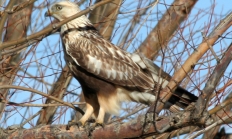
Search myodfw.com
Few birds are as astonishing as the American dipper. This nondescript, dark brown to gray bird is seldom seen more than a few feet from the water's edge. Its elaborate song, which can come forth even on cold winter days, is readily heard above the noise of rushing streams. This bird's ability to dive into a rushing stream to forage on aquatic invertebrates and reappear in the same location has elicited wonder and excitement from ornithologists, naturalists, and birders as well as envy and adoration from fly-fishers. It is an uncommon year-round resident in montane streams and rivers throughout Oregon

This is a mouse-like bird, only occasionally musters the courage to dart from its shadowy domain. The male and female are generally indistinguishable by external characters. Both sexes are small and brown, with dim streaks on a paler, often pinkish breast; generally paler and grayer in drier regions. Both sexes sing; the female's repeated single note is easily distinguishable from the male's fast trill introduced by several individual notes. The Wrentit is a resident along the coastal slope; in the Columbia River Lowlands and in the south inland to the west Klamath Mountains. It uses a wide range of habitats
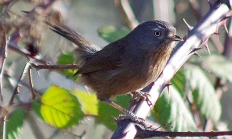
In Oregon, the opossum is considered an invasive species. The Virginia opossum is a cat-sized mammal with a pointed nose, unfurred, black, leathery ears with white edges; beady eyes; a hind foot with an opposable hallux (big toe); and a naked scaly tail. It was introduced in Oregon between 1910 and 1921. Populations were established in northwestern Oregon apparently from releases of animals brought to the state as pets or novelties. Small streams, forest communities, and agricultural lands planted to a variety of crops are typical of many habitats occupied by Virginia opossums in Oregon. They are active nocturnally and

Columbian ground squirrels occur in the Wallowa and Blue Mountains in small openings and meadows in forested areas. Most of these areas flood each spring so the ground squirrels are restricted to the edges of meadows or to mounds within them. Columbian ground squirrels spend an average of 245-255 days in torpor and an average of only 69-94 days active. While above ground, they spend more time alert than in any other activity. This ground squirrel engages in a greeting behavior that resembles kissing, touching mouth and nasal areas usually for one to five seconds before other social behavior. Photo
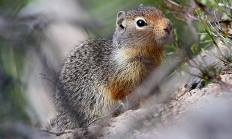
Hunting involves a deadly weapon that can kill more than just your target. Hunting and handling your gun safely MUST be a top priority. Start with the fundamentals Start by learning these four gun safety fundamentals and you’ll be well on you way to a lifetime of safe hunting. Assume all guns are always loaded. The primary benefit of handling all guns as if they were loaded, is that it will help you develop safe gun handling habits. Never let the muzzle of the gun (the shooting end) point at something you’re not willing to shoot. Often referred to as

Hunter's Guide Hunter's Resources Hunter's Technique Hunter's Bounty
Online Learning
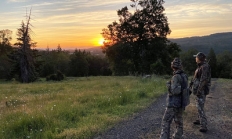
SE WILDLIFE VIEWING December 4, 2025 Harney County This time of year, in Harney County, wildlife viewing is typically targeted towards waterfowl, a variety of shore birds, and raptor species. Look to Malheur National Wildlife Refuge or any of the various reservoirs in the county which should have good water this year. Raptors are present in the district and opportunities abound throughout the county. Look on fence posts, telephone poles, and amongst cliff and talus slopes to see a variety of species that include red-tailed hawks, prairie falcons, ferruginous hawks, golden eagles, and Swainson's hawks. Many passerine species such as
A big, well-mannered bird of friendly, even playful disposition, with an abundant curiosity as to human presence and activities within the realm of open ocean over which he presides. Long-winged, to seven feet, and dark sooty-brown; adults have a white rump and feathering, which juveniles lack, around the base of a large bill. Every sighting of these gentle giants gliding up to the boat evokes delight. The black-footed albatross is a regular visitant spring through fall offshore, but is irregular in winter. They glean squid, fish and fish eggs from the ocean surface and also eat galley scraps. Hear the

One of the most impressive sights in the unforested regions east of the Cascades is a Prairie falcon strafing a Belding's ground squirrel colony repeatedly at full speed in hopes of catching one emerging from its burrow at just the wrong moment. Prairie falcons are most common in rimrock country where they nest, but may travel great distances in search of prey. Prairie falcons are large, sandy brown above and off-white with variable amounts of streaking below. The face has a vertical stripe below the eye, as do many falcons. In flight, the long, pointed wings and long tail identify
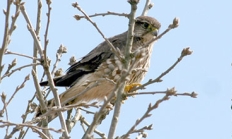
A conspicuous wader of shallow wetland habitats with a striking appearance and graceful movements. These long-legged shorebirds have contrasting black and white upperparts and during the breeding season, the head and neck turn from gray or white to a deep rust color. One of their most notable traits is a long, slender upturned bill. It is a common breeder east of the Cascades at wetlands of south central and southeast Oregon. Distribution and number of breeding birds vary annually depending on regional and local water levels and habitat availability. Regardless, most breeders occur in the western Great Basin counties of
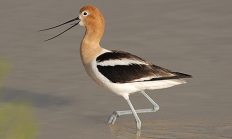
Heermann's gulls, the warm-water gulls of summer and fall, accompany Brown pelicans as they fly north each summer. Although most feed along the shore or in the ocean, some feed on tide flats. They often steal food from Brown pelicans. They may take fish directly from the pelicans' bills immediately after a dive or claim food that pelicans have located, discarded, or disturbed. This gull is common on the outer seacoasts, beaches, bays and estuaries. They are strongly associated with outer coasts and adjacent ocean waters, usually within a few miles of shore. A few wander inland during the fall

The plumage and perching habits of the Eastern kingbird make it one of the more conspicuous birds in open habitats of eastern Oregon. The plumage is well defined: black on the upperparts and white on the underparts, and a white band on the terminal tip of the tail feathers. It is a relatively large flycatcher, often perching on powerlines, fences, or exposed perches on trees or snags. They hawk aerial insects during the breeding season. The Eastern kingbird breeds throughout non-forest of most of northeast Oregon lowlands with spotty distribution in central and southeast Oregon. They are most abundant in
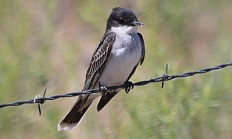
With its long, forked tail and long wings, it is the most graceful of all land birds and reminds one of the smaller terns not only in shape but in behavior. The Barn swallow has taken so completely to nesting on human-made structures that one forgets they were once restricted to caves and rock crevices. Almost every farm in the state has a pair or two nesting in an outbuilding, and very few bridges do not have a pair or two. It is the best known of the swallows. It is a fairly common to locally abundant summer resident and

A group of twittering, tiny gray birds streaming through bushes and trees and across openings surely are Bushtits. Females' eyes are pale, males' dark. They are highly gregarious except when nesting. The intricately made sock-like nest is unusually large for the size of the bird. Bushtits show a distinct indifference to humans and regularly nest within residential neighborhoods and establish foraging routs throughout many cities. They regularly take suet at bird feeding stations and visit backyard birdbaths. The Bushtit is a fairly common resident throughout Oregon except in Umatilla, Union, and Wallowa counties and at higher elevations of mountain ranges

Canvasbacks are large; adults in good condition are as heavy as mallards and second in size only to the white-winged scoter among common Oregon ducks. Drakes have a reddish head and neck; black breast, lower back and tail coverts; nearly white back, flank, and belly, and dark gray tail. The hen is grayish brown with a darker brown head, neck, breast and tailcoverts. It is an occasional summer resident in northeast Oregon, nesting locally only at Ladd Marsh in Union County. It is an uncommon spring and fall migrant in northeastern Oregon and regular in winter and spring on the

Ruffed grouse are named for a series of black iridescent feathers on the sides of the neck called the ruff, which is erected by males to form an ring around the neck during courtship displays. This forest-dwelling species, favored by upland game-bird hunters, is well known for the drumming of the males during courtship displays in the spring. It is a common resident throughout most forested regions of the state. It occupies most forests at low to moderate elevations east of the Cascade crest, primarily the east slope of the Cascades from Ft. Klamath and upper Klamath Lake and Blue

The rat-sized American pika is characterized by rounded ears, no external tail, bare planter pads, and hind feed scarcely longer than the front feet. The pika requires talus, creviced rock, and other high elevation microhabitats that provide cool microclimates. Adequate forage close to rocky crevices is needed. In Oregon, the species is limited to suitable habitats in the Cascade Range and the Wallowa, Blue, Strawberry, Steens, Hart, and Warner mountains, and at Newberry Crater in Deschutes County and Grizzly and Cougar peaks in western Lake County. The American pika is an Oregon Conservation Strategy Species and is limited by its

The pied-billed grebe is an aquatic species that breeds at the edge of open water in freshwater lakes, ponds, sluggish rivers, and marshes. When disturbed, it sinks like a submarine, rather than diving, and re-emerges with only its head above water. This is a brownish grebe with a black vertical bar in the middle of the rather stubby, whitish bill, and jet-black throat patch on both sexes in alternate plumage. It has a surprisingly loud "yelping" call within a marsh. Young have striking stripes on the head. This bird is widespread and common in Oregon. It winters locally in open

Characteristic of open country and cold weather, the Rough-legged hawk can be found soaring over exposed terrain or perched on utility poles across much of the state in winter. The rough appearance of its legs comes from the feathers covering their length, an adaptation that provides extra warmth in frigid weather. In flight, dark wrist patches and belly help identify this large buteo, though like other hawks it is subject to much variation in plumage. From a distance it frequently appears to have a frosty upper half. It often hovers over fields while hunting, a behavior that is rare among
